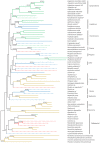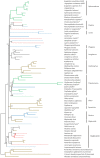Argopistes sexvittatus and Argopistes capensis (Chrysomelidae: Alticini): Mitogenomics and Phylogeny of Two Flea Beetles Affecting Olive Trees
- PMID: 36553462
- PMCID: PMC9777630
- DOI: 10.3390/genes13122195
Argopistes sexvittatus and Argopistes capensis (Chrysomelidae: Alticini): Mitogenomics and Phylogeny of Two Flea Beetles Affecting Olive Trees
Abstract
The genus Argopistes (Chrysomelidae: Alticini) is the only group of flea beetles specialized in plant hosts in the family Oleaceae. In southern Africa, Argopistes are often found feeding on African Wild Olive (Olea europaea subsp. cuspidata) and European cultivated olive (O. e. subsp. europaea), and heavy infestations can be devastating to mature trees and compromise the development of young trees. Despite their negative agricultural impact, African Argopistes are an understudied group for which no genetic data were available. We assessed the species diversity of olive flea beetles in the Western Cape province of South Africa, the largest olive-producing region in sub-Saharan Africa, by collecting adult specimens on wild and cultivated olive trees between 2015 and 2017. Argopistes sexvittatus Bryant, 1922 (n = 289) dominated at all sampling sites, and Argopistes capensis Bryant, 1944 (n = 2) was found only once. Argopistes oleae Bryant, 1922, a third species previously reported in the region, was not found. The complete mitogenomes of one A. capensis and two A. sexvittatus (striped and black morphotypes) individuals were sequenced for phylogenetic reconstruction in the context of other 64 species. The two olive flea beetle species form a monophyletic clade with other Argopistes, supporting the hypothesis that the exclusive feeding habit on Oleaceae is an evolutionary adaptation in this genus.
Keywords: DNA barcodes; Olea europaea; South Africa; mitochondrial; olive flea beetles; phylogenetics.
Conflict of interest statement
The authors declare no conflict of interest.
Figures









References
-
- Feeny P., Paauwe K.L., Demong N.J. Flea beetles and mustard oils: Host plant specificity of Phyllotreta cruciferae and P. striolata adults (Coleoptera: Chrysomelidae) Ann. Entomol. Soc. Am. 1970;63:832–841. doi: 10.1093/aesa/63.3.832. - DOI
-
- Bukejs A. To the knowledge of flea beetles (Coleoptera: Chrysomelidae: Alticinae) in the fauna of Latvia. 1.1 genus Chaetocnema Stephans, 1931. Acta Zool. Litu. 2008;18:191–197. doi: 10.2478/v10043-008-0029-5. - DOI
-
- Bienkowski A.O., Orlova-Bienkowski M.J. Quick spread of invasive rose flea beetle Luperomorpha xanthodera (Fairmaire, 1888) in Europe and its first record from Russia. SPIXIANA. 2018;1:99–104.
Publication types
MeSH terms
LinkOut - more resources
Full Text Sources

